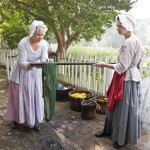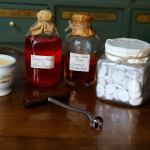
I love writing things down. When I got the position of Apprentice Weaver a few months ago, I knew that I would need to document what I was learning, and the significance of it all. So I got a new diary and started taking notes and just jotting down ideas throughout the day and when I got home after work. Here are a few of those entries that paint a picture of the start of this new chapter in my life and career here with Colonial Williamsburg.
I started as an Orientation Interpreter in Colonial Williamsburg in the summer of 2013, and in that position spent many days at all the trade shops around town. As I answered questions about the shops—as well as embarking upon so many fascinating conversations about all kinds of things relating to Williamsburg—I wondered what life was like on the inside, as a tradesperson. The Weaver Shop became my favorite haunt right from the beginning, because the textiles they made were so beautiful, the information they shared so interesting and relatable, and they just seemed to have so much fun doing it. The first time the shop had an opening for an apprentice while I was here, I didn’t believe I had enough to offer. So after that, I spent time on my own visiting the shop and trying my hand and spinning and even a little weaving. I was hooked and kept investing more time in addition to growing as an interpreter in Colonial Williamsburg.
When another apprenticeship became available, this time I applied and it went to a very deserving co-worker of mine. I was so incredibly happy for him, but decided that if another opportunity arose, I would try again. When the next spot became available, I again applied and this time was successful! At the start of this summer season, I switched from the Orientation Interpreter position to Trades. Reading up a bit before I started, I realized how much there is to learn, which made me both incredibly excited that I would now be able to devote time to learning it and also very nervous. But thankfully, I work with a fantastic group of people who have made my transition so smooth; they encourage and teach and make me very happy to be an Apprentice
June 8: Practice Makes Progress
I’ve been in the Weaver’s Shop many, many times before over the past three years. But today is really different. Today, I am an Apprentice Weaver and the Master of the shop, Karen, is here with me alone to properly introduce me to the tools we use. We aren’t open to the public today, so I’m not too embarrassed when the shuttle doesn’t always make it from one hand to the other, or when my yarn is spun so clumpily it barely makes it through the hooks on the spinning wheel. I learned so much about how physical this job is, about how to deal with mistakes (particularly when Karen cut five warp yarns at one time so I would learn how to fix them), and that when a project feels overwhelming, it’s helpful to remember “it’s just string.” Karen is full of encouraging mottos—I feel so privileged to learn this trade from her. The most fitting for today: “practice makes progress.”
June 16: Finding My Way
I am getting my footing in the shop, having been a Weaver for a week now. I still feel a bit guilty that I get to work in a temperature-controlled building. My first three years with Colonial Williamsburg were spent as an Orientation Interpreter, outside helping guests as they navigate the town and different sites. I thought this was a physically challenging job on day one!? I am definitely feeling the results of working on a loom for a few hours a day—mostly in my shoulders from using the beater bar and in my rear from pivoting on the bench to press the pedals. This week has been about learning to talk about everything we do here in the Shop while at the same time actually doing it. There’s a whole new language to learn, not only in the names of specific tools and machines we use, but also in talking about 18th-century textiles. I’m certainly experiencing the more-I-learn-the-less-I-know phenomenon when it comes to names for different fabrics, elements of textile manufacture, and the general history of all of this material. I’m very glad that an apprenticeship is at the very least five years long.
July 9: I Survived My First Dye Day!
What an excellent first dye day as an apprentice it has been so far! With a moment to cool down, I’m at my desk trying to remember more from the college chemistry class I took as freshman, unfortunately with little luck. We have three dye pots to work with today in primary colors: cochineal insects for red, indigo for blue, and fustic for yellow. We have a good rainbow of skeins and small fabric squares! Understanding the world of the 18th century as a vibrant and color-filled place sheds a new light on many aspects of Colonial Virginia. I can more easily imagine a tavern on Duke of Gloucester St. when I see it full of people with brilliant indigo blue jackets, deep cochineal scarlet suits, and bold indigo and fustic green petticoats. Because our shop encompasses a few different aspects of textile manufacture, we dye about once a month, but I am already looking forward to the next dye day.
July 20: History Repeats Itself - In the Very Best Way
I have seen textiles from the 18th century and earlier before today. But never before have I had the same understanding when looking at an original fabric as I have right now. For the last six weeks, I have spun the same way these yarns were spun and I have used looms very similar to the looms that made these fabrics. I understand a tiny fraction of what life looked like for an 18th-century Weaver, but I have sat on that bench and watched as the cloth forms before my eyes, just like they did. To be able to visit Colonial Williamsburg’s Collections is such a treasure. Kim Ivey was kind enough to show me and my fellow apprentice Annie a number of drawers in the textile section full of original pieces. We saw cozy bed rugs (popular blankets in Colonial Virginia made by tying bundles of yarn onto certain yarns as the cloth is woven) and a beautiful cotton dimity, among an amazing array of fabrics. Those two particular textiles are the next projects we will embark upon in the Shop. Connecting the physical ins and outs of my day with this evidence of life from the 18th century is why I chose to work in a history museum. I feel like I’m part of this big world, and I get to show that life to the guests who visit the Weaver’s shop.
August 15: The Best is Yet to Come
I reflected earlier this morning that there is no way I have been working in the shop less than three months. I had to consult a calendar, and sure enough, time is flying. I can’t believe how much I’ve learned, and in so many different arenas. Jason, one of my co-apprentices, and I have been reading about the history of looms—there is plain woven cloth found at Catal Hiyuk that is 8,000 years old!; I’ve read a few articles on bed rugs, which has led to a better understanding of textile producers in England and their relationship with the colonial market; I can spin cotton fairly well; and I love the feeling of working on the loom and being able to speak coherently as I work. I like to tell guests that I’m very happy to be an 18th-century-style weaver. I’m usually referring to the long hours and the fact that they were paid for what they produced rather than for their time, but more than that, I love sharing how our cloth is made with guests how may never have thought about it before. Nobody was visiting 18th century Weavers at their looms. Not only does it connect people to the 18th century, but it also relates to the clothes they are wearing when they come inside. I do get the privilege of actually weaving, of creating something everyday, but even more so—I get to share it with everyone who comes through the door.
A special thank you to Fred Blystone and J.A. Lyon for the images featured in this blog!
GUEST BLOGGER: AUBREY MOOG
Aubrey Moog is an Apprentice Weaver at the Spinning, Weaving, and Dyeing Shop in Colonial Williamsburg. Before coming to CW she studied film at New York University. Upon graduating she discovered that the film industry was not the best fit, and she got a summer job in her hometown at a museum where she volunteered from fifth though seventh grade. With the discovery that public history connects so many of her interest and a renewed love for the 18th century, she stayed past that first season three summers ago and hasn’t left since. She still enjoys watching and sometimes making films, keeping bees, ready 18th-century poetry, board games, and playing music. Even on her off days you might find her exploring Colonial Williamsburg with her dog Dottie.


It would be lovely to be able to “read along at home”, can you put up a bibliography of what you are reading?
Did not mean for this photo to be put up, 😐 sorry
Denis L Gendron says
Nice where was this reinactment occured ad when …love it
Enjoyed reading your article, Audrey! I always enjoy stopping by the Weavers shop on my visits to Williamsburg. The new shop is great for the visitors, being able to get up close and personal with the machinery and the interpreters, it really adds to the experience! I hope that you continue to enjoy your opportunity to learn from Karen, she is a gem!
Sorry Aubrey, not Audrey!!!! My apologies!
Your blog and job would be a dream come true for me.
Jane Hanson says
Great article, Aubrey! So happy for you and your new apprenticeship. Having worked for Karen myself (yes, she was the Manager of Performing Arts at one point) I know she is a great encourager and motivator. All the best!
Robert Hughes says
Tis is a great blog. Love the info on your quest to become a weaver.
We have a small alpaca farm in King William and I do some weaving myself. Certainly not full time as I have a farm to run.
I have always enjoyed meeting weavers and seeing the products they produce. Many are very talented and are happy to share what they know.
Keep up the good work.
If you can spin cotton decently after only a few weeks of spinning, consider yourself talented! I’m one of CW’s visitors who knits, spins, dyes, and who is learning to weave. It is daunting to think that 241 years ago, when you “are”, as an apprentice, all cloth was painstakenly spun, woven, and dyed by hand. - no wonder clothes were picked apart and their fabrics repurposed until they were sold to the rag man to make paper with. Best of luck to you on your fibery journey. Ah, if I lived in CW, I’d be applying for an apprentice position like yours. Keep up your journal - perhaps you can write up some weaving patterns, dye “receipts”, and knitting patterns for handspun and CW will publish it. You should post to Ravelry, if you have a moment.